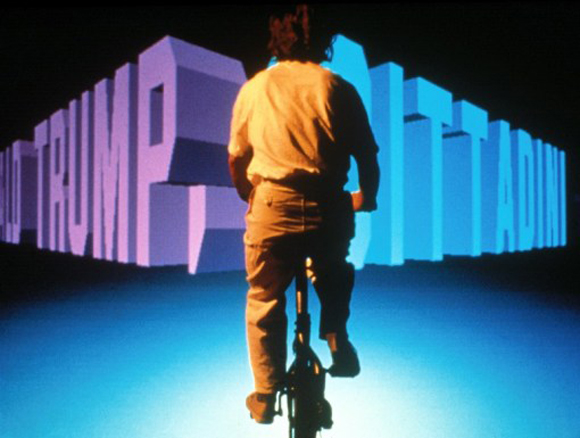
Jeffery Shaw, The Legible City, 1989. Computergraphic Installation. Collection of ZKM-Medienmuseum, Karlsruhe, Germany.
Digital archiving has lately become a much-discussed topic. The illusion of “everlasting†files, advocated at the beginning of the digital revolution started crumbling away, giving way to a perception of digital formats as one of the most ephemeral documents. “We ought to have a very good strategy for digital archiving†says Hiroko Myokan, former curator at Inter Communication Center (ICC), Tokyo and currently working on archiving the very first media art festival in Japan between 1986–1999, for the Agency for Culture in Japan. On a recent visit to Montreal for BIAN 2012, Mutek and Elektra festivals, Myokan and M-KOS resident editor and digital artist Oli Sorenson freely discuss digital archiving as a key phenomenon to our contemporary condition.
Oli Sorenson [OS]: When we first met in Japan two years ago, we had an interesting talked about digital archiving. You were also in a transition period from working as a curator for ICC to going back to studying. Are you still studying now?
Hiroko Myokan [HM]: Yes, I’m still studying archiving and preservation of media art in Linz Krems, Austria but I’m also doing research for the Agency for Cultural Affairs in Tokyo about the first video and media art festival that happened in Japan between 1985 and 1999, in the Fukui prefecture.
OS: Were these well archived?
HM: Actually, yes. It’s a very rare case. They don’t have any video documentation but only printed materials as well as some broadcasting archives from the local TV broadcast company.
OS: That’s great. Sometimes I think it’s impossible to keep digital archives. With Moore’s Law, every 18 months technology is reinvented into something twice as powerful, for half the price. And in the 21st century it seems very much, when you say archive or documents, it’s understood as a digital document.
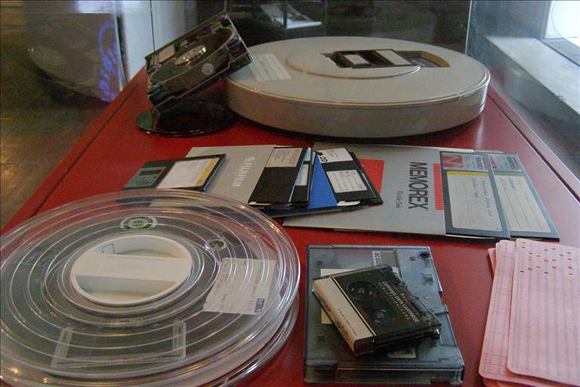
History of computer storage. Image via hectorcorrea.com
HM: I know what you mean. The digital format is not a stable media. I think the most stable way to archive is actually in an analogue way. Film, for example, archiving with celluloid images is stable but unfortunately many labs have closed down. It has become more expensive to preserve things in analogue so we cannot avoid using digital formats. I think we need to have some strategies to use digital formats.
OS: I remember you previously said there are three avenues in how we can archive digital works: we can either keep them in their original form and hope they are still readable in the future, keep upgrading them when better formats come along, or just accept their ephemeral qualities and eventual disappearance.
HM: I don’t have a clear answer now. It depends on what you want to archive. To be honest, I’m quite pessimistic about preserving or keeping the originals of media art. It is very difficult to keep the artwork itself. What can we archive? One of the answers is archiving the documents or related materials, for example, flyers, catalogues, descriptions, blueprints, system descriptions and so on. These materials keep some of the possibilities to reproduce or remake the work later. That’s very important. Also archiving the audience’s experience is important because most media arts are like performing arts, they are time based and space based. So, the way dance productions, theatre and performing arts are archived, these are good references for media arts. For example, a performance script is essential, as much as the actual moving image is helpful to understand the work. We should keep different kind of archives as much as possible to have a total archive.
OS: What you are saying is a definition, the definition of digital art in its association with the way it operates. And it seems much closer to theatre and the performing arts, and in relation to these two, it is defined as ephemeral. If you compare that to visual art, which has in its structure, a whole system of objectification with the art market, which is difficult to associate with digital art because, is there an object to market here? And going back to the archive, the archive can potentially become the object. The archive as marketable object is very much associated to land art or conceptual art. For example, in Christo’s wrapping of architecture and so on, these can’t be consumed. So he was selling his preparatory drawings to finance his projects, which are the real works, but they’re not done yet. So consuming the archive or preparation, or study of the actual work becomes the object.
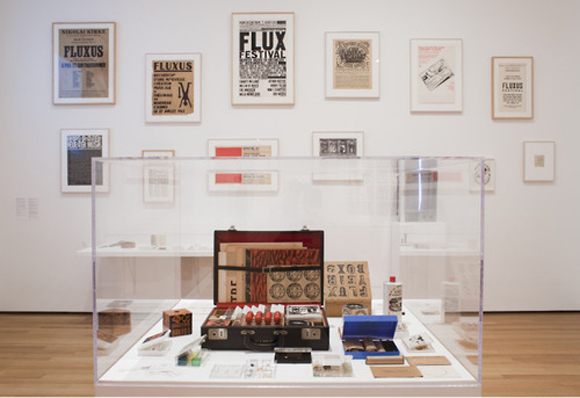
Fluxus Preview, Exhibition view at MoMA, 2010. Courtesy of MoMA. Installation photo by Thomas Griesel
HM: It’s also good to use the Fluxus movement as an example. Fluxus is an activity based movement so that when works are exhibited, they are often flyers or other documentations, and photographs in display cases. I think these kinds of secondary material of the actual piece of art becomes valuable, consumable as well as collectable. So I think this could happen to digital or media art.
OS: There was a promise from the digital format in general, not specifically about digital art, but at the beginning of the digital revolution, everyone was advocating digital things as eternal because you could copy them without any loss. In terms of its storage capacity however, in passing the test of time, they won’t last forever. It turns out to be the most ephemeral format.
HM: That’s become a problem and we have just realized this now, like CD-ROMs or floppy discs. These are not stable but short-lived.
OS: But on the other hand, because of their impermanent quality or because the technology moves so quickly, digital formats have become markers of specific periods in time. For example, floppies in the 80s, CD-ROMs in the 90s, and so on. You can trace back the production period even without opening the content from its storage, you can tell which decade the work came from. That’s one positive aspect.
But I think I’m more pessimistic and critical as well. I think it’s interesting to be critical. As far as I know, there have been very little criticism of the medium itself. For example, in digital art festivals, you encounter some criticism in the subject matter, such as with environmental, financial and political issues, and so on… But there is no criticism about the medium itself. If you take painting as an example, if you are a serious painter then you have to address a series of questions about painting itself, as a medium, which doesn’t really happen in digital art.
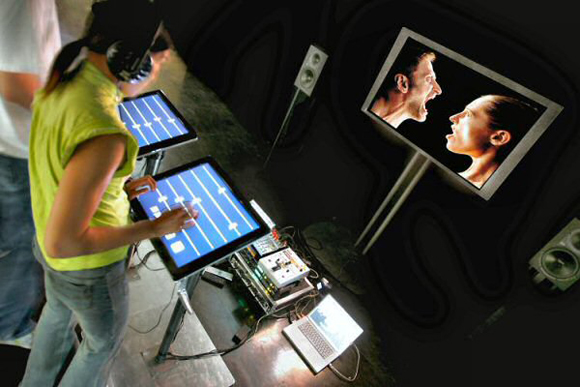
Marie Chouinard, Cantique #3, 2004. Interactive installation. Courtesy of Marie Chouinard. Source: Daniel Langlois Foundation
HM: I agree. For the last a few decades, media artists have always been playing with new media or technology without thinking so much about media itself. But I feel that recently things have started to change a little. Perhaps because the speed of technological development has slowed down, compared to before, so that artists have more time to reflect on the medium as a tool.
OS: The idea of innovation in digital art also makes it more opaque. Sometimes you cannot get to the content of digital works because the first question you ask is always “how is it made†rather than what the artist tried to express. There is a kind of obsession towards digital art about the way it is made or what kind of technology is used, making the content become secondary.
HM: The concept of media art and the quality of media art always seem to change depending on the technology market. As we mentioned earlier, in the 80s and 90s we see a difference of technology. Media art is constantly changing based on or in parallel to technology.
OS: Yes. Because this art relies on a market and it’s very expensive, it also relies on funding a lot. The cooperation of corporate sponsors for art events and so on make it very difficult to be critical because all the big companies or funding bodies are expecting the artists to make their products look nice. So by definition it’s very difficult for a digital art event to invite, let’s say, artists destroying brand name products as an artistic expression or as a concept.
HM: Recently I noticed younger artists don’t really care about the art scene but they work a lot for such companies, for the actual commercial products. In fact companies started being interested in young artists using interactive media, expressing themselves through media for more artistic promotion. For example, my friend works for Moment Factory, which lately produced spectacular images and stage designs with state-of-the-art technology. With such changes in mind, I feel that we are now ending the first stage of media art as an art form.
OS: So, at the current stage, how do you define media art?
HM: Media art is in between art, entertainment and design. Media art has been developed not only by artists but also engineers, scientists and designers.
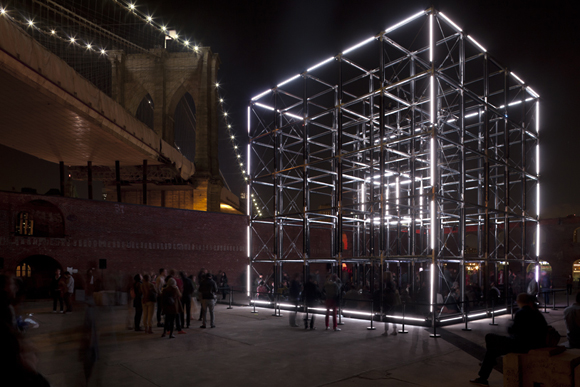
United Visual Artists, Origin, 2011. Installation view, part of The Creators Project NY. © United Visual Artists
OS: As we talked so far, we have been freely switching between digital and media art, to speak of artists using technology. But Alain Thibault, the artistic director of the International Digital Arts Biennale, insists on drawing a very clear line between digital and media art, and working towards taking digital art closer to, or in the same venues as contemporary arts.
HM: For me media art includes games and even mangas or such sub genres of sub cultures. This is why I think some examples of media art are very close to entertainment. However, these days I noticed the distance between contemporary art and media art is getting narrower. For example, the ICC, the media art centre in Tokyo, started inviting contemporary artists. These days there are two types of media artists, some have started focusing on showing in museums or art institutions and others want to work for entertainment industries or in more commercial ways.
OS: There are so many media art festivals, which are not necessarily the territory of museums or pure entertainment. You have all these very festival specific works such as mapping and audiovisual performances, all these are very creative and some are sophisticated enough to be considered artistic in their own right.
HM: I think the museum system or the collection system is changing. I mean, for example contemporary performance artists using media or digital tools. This is difficult to preserve for the museum curator or conservator, they have to think about the strategy of how to collect works.
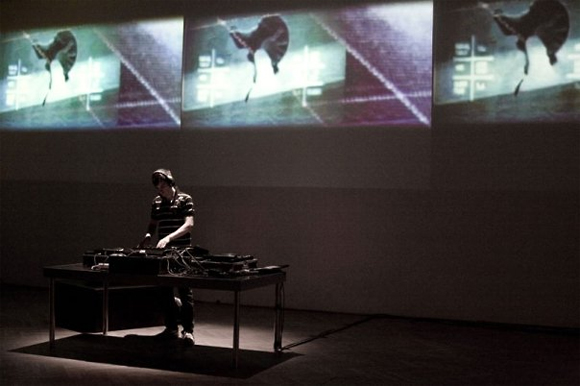
Oli Sorenson, Subject Zero, performance at Sound:Frame Festival, KuenstlerHaus Museum, Vienna, 2009. Courtesy Oli Sorenson
OS: Now we can store all the media and digital artworks in tiny hard drives, this is very tactical in terms of storage. In just a few terabytes you could store a few decades of 21st century art. But again we are blurring line between the archive and the actual work, which is central to your preoccupation.
You once told me that your research referred a lot to the Daniel Langlois Foundation’s DOCAM [Documentation and Conservation of the Media Arts Heritage]. Can you tell us about it?
HM: DOCAM was a four-year project between 2004 and 2009. They researched a lot on the preservation and documentation of media art. You can find all their research reports on their website. They have an entire list of restored artworks including John Cage, Nam June Paik, Jenny Holzer and so on. Their report is excellent. They also include a technical section on how to change formats, how to preserve media, as well as a suggested policy for reproducing or restoring such works of art.
I was interested in their report on the authenticity of media art. It is a very difficult, complicated and important question. In their report it says that the most important thing is to preserve the authenticity of media art. Of course it is also important to preserve documentations but in most cases it’s impossible, because of the electronic materials or its storage, dated computers and other hardware get broken so easily, as we said earlier, they are not permanent objects.
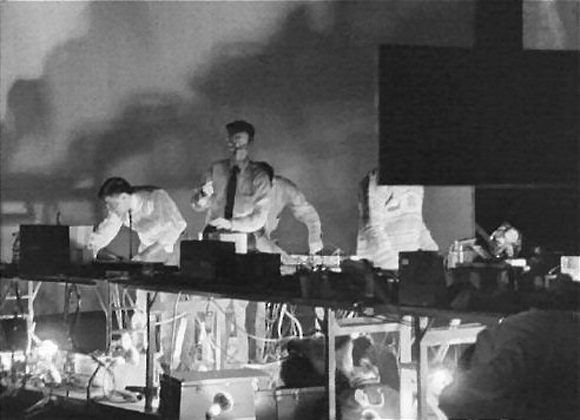
John Cage, Variatons VII, 1966. Performance presented as part of 9 Evenings: Theatre and Engineering, The 69th Regiment Armory, New York, N.Y., United States, October 15-16, 1966. Source: Daniel Langlois Foundation
OS: What solution did they propose in terms of authenticity?
HM: They produced three maps based on many cases. First you have to talk to the artists. If the artists want or not to change part of their work, which can’t be reproduced or restored. Secondly, you should keep and collect similar machines and models for back ups in case of future presentations. If this is impossible or very difficult, then, thirdly you have to think about adapting the works to more current hardware. There are three important protocols in doing this. All this information is on the DOCAM website.
OS: What about Photography? Now that it’s become digital, it faces the same archiving challenges as other digital works. Now even painters and sculptors who want to document their work in pictures need to it via digital material. Even if you want to draw an architectural plan or write a text, the computer has become this common denominator. So it’s become a universal issue, not just for digital artists but all creators these days.
HM: And not only artists or creators but all of us use the digital format for documenting life, family photos, tourist snapshots and so on.
OS: On a higher level, it’s a question of memory, how to preserve memory, collective memory.
HM: I know. Recently there was an interesting exhibition called “Collecting WWWorld – The Artist As Archivist in the Internet Age†in Basel, Switzerland. It was a group exhibition by net artists and net artists as archivists. They used found photos on the internet: Flickr, YouTube and so on. One artist made a documentary film by using photos from these websites. Which is very much a work of art made by huge archives accessible to everybody. I found it an interesting concept. Even artists can become archivists.
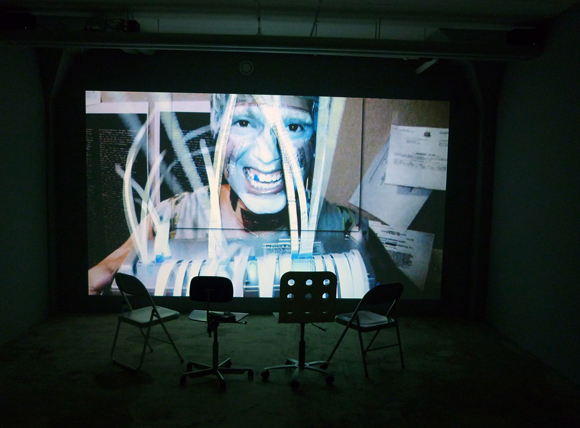
Work by Ryan Trecartin, Exhibition view, Collecting WWWorld – The Artist As Archivist in the Internet Age at House for Electronic Arts Basel, 2012. Courtesy of the artist and House for Electronic Arts Basel
OS: I’m also fascinated about artists becoming some kind of filtering agent, especially for what’s online in terms of this overabundance of content. How does a casual viewer, someone who isn’t necessarily an artist but an art enthusiast or someone who is culturally aware, how does a person like that make sense of it, or not get overloaded with information? All this content is on the same level without any hierarchy.
HM: Unfortunately I couldn’t go see the exhibition in Basel but I read the catalogue. And in there, it says the authorship of art is changing. It talks in particular about museum collections and its underlying system that it will be kept by sharing. Before the collection was closed to the public and that created a certain power over them. But now such a system is being destroyed by the internet. You can access more and more information and indexes of images on the internet.
OS: When you talk about sharing or how easily accessible it is, then the danger is to fall into questions of copyright, a concept that was defined before the internet so now it becomes very confusing to talk about copyright in this format.
HM: I think now is a very dynamic moment for ideas of copyright and authorship. It has been said that history was written by the winners. Now that we have a shared collective memory, that means we have a different history then the one made by history books. Same thing applies to art history. We could change art history. So it is interesting to see exhibitions like “Art Histories†at VOX, about art history from the point of view of artists, so as to rewrite new contexts or appropriate them.
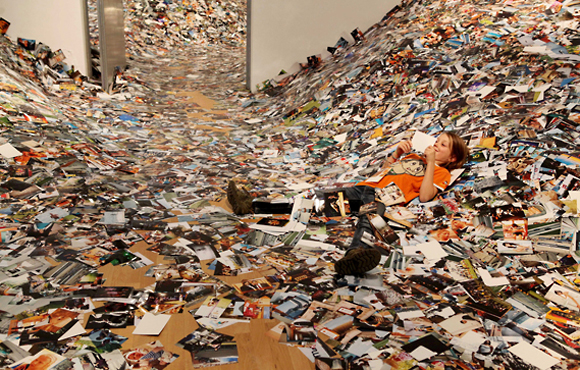
Erik Kessels, Installation view at Foam, Amsterdam, 2011. Courtesy the artist and Foam. Photo by Gijs van den Berg
OS: When you talk about modern artist redefining the history of art, it’s been done before in many ways, but here the novelty is rather than stirring a revolutionary movement, its about the management of objects and roles, artists as curator and artists as archivist, art historian and so on…
HM: The roles of these specialists have changed so much, now there’s no point to separate them.
OS: Literally everyone at all levels of society use computers. I think this is maybe why the idea of Duchamp’s readymades, and especially assisted readymades, are still relevant today. In a way, this is what you are doing with a monochrome painting. All you’ve done is applied some red paint on the canvas and hang it in the gallery. It becomes an assisted readymade with tubes of paint. So now, a whole generation of artist are producing computer assisted readymades, without thinking about all the engineering behind Photoshop for example, when they click once, twice on a file and say, “voila, I did thisâ€. How different is this from sampling?
HM: It’s an interesting point. I’m also interested in our present situation, that everyone use computer without thinking about the operations behind, and as you said it’s a new generation of readymades.
OS: We inherited this idea of readymades more than we think and perhaps in order to move forward from this situation, we may need acknowledge it, or maybe wait for a 21st century Duchamp? â–
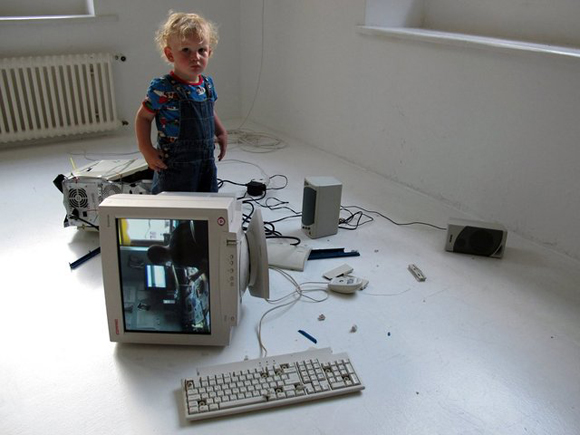
Eva and Franco Mattes aka 0100101110101101.ORG, My Generation, 2010. Courtesy of the artists and Carroll/Fletcher, London
